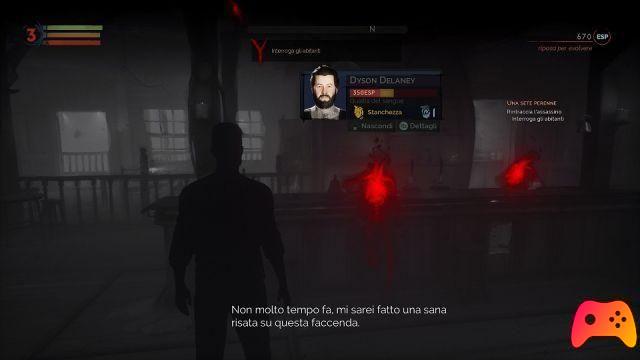
Review for Famicom Detective Club: The Missing Heir & The Girl Who Stands Behind. Game for Nintendo Switch, the video game was released on 14/05/2021
On the same console that gave birth to games like The Legend of Zelda and Metroid, the NES, through an external device that allowed the use of floppy disks, appeared a duology destined to become a cult of the investigative genre in Japan: i Famicom Detective Club, respectively The Missing Heir & The Girl Who Stands Behind of 1988 and 1989. These two chapters at the time were said to have made since pioneering the genre, clearing the yellow stories in Japanese schools and using the folklore of rural communities to tell a story and persuade the player to insert one disk after another to complete the picture.
After 30 years, Nintendo has chosen to give new life to these games that have disappeared from the radar and are remembered with nostalgia. Famicom Detective Club: The Missing Heir & The Girl Who Stands Behind tell two stories full of twists where the yellow genre mixes with that of horror giving life to suggestive and suspenseful scenarios, and they do it in a completely dubbed version in Japanese and with a shocked and totally new graphic style. The first, then, did not have the same luck as the second (which was instead re-proposed on SNES), aging rather badly. The duology so far has been the preserve of only the Japanese public and a faint word had spread through translations created by fans. Today they officially leave the Japanese borders on Nintendo Switch.
The Famicom Detective Club are two visual novels created in the late 80s by the pen of Yoshio Sakamoto (who achieved popularity with Metroid) they see us take on the role of a young detective who we can give the name we want, and we will be called to investigate two particular cases that will also lead us to discover something about the life of the protagonist. It is important to know that on a chronological level the two stories are reversed.
The Missing Heir, the first title released in 88 can be considered the sequel to The Girl Who Stands Behind instead came out the following year. Nevertheless, you can freely choose which title to play first, and discover the various references present.
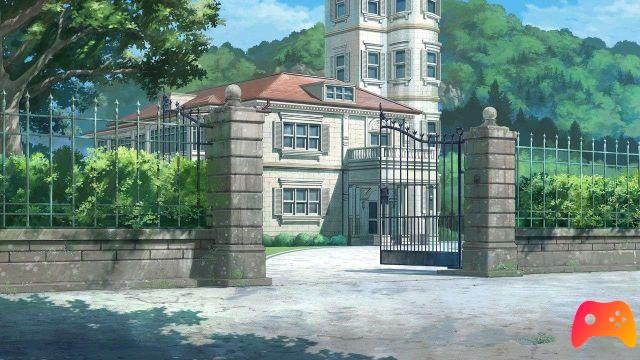
In The Missing Heir the protagonist is called to investigate the death of the head of the family Kiku Ayashiro. To ask for her help will be the butler, who does not at all believe that the cause of the death of the matriarch Ayashiro is due to a simple heart attack the evening after the reading of the will. The investigations take place near the Myoujin village, where the residence of the Ayashiro family is located, one of the richest in Japan, whose power dates back to the Sengoku period. There is a curse on the Ayashiro which originates precisely in this period: it is said that if the head of the family dies in vain, he will rise from the grave to take revenge.
It is not long before the locals say they have seen Kiku wandering around the village, and it will be up to us to find out if what they say is true or mere suggestion. Shedding light on the issue is not the only thing we are called to do, but we will also have to recover our memory: at the beginning of the game we will be rescued at the foot of a cliff and we will have to put together the pieces that make up our memories. Fortunately we will not be alone, to help us there will be the beautiful Ayumi who will always be ready to wait for us at the Utsugi agency where we have the opportunity to put our ideas in order and summarize everything we know about the case.
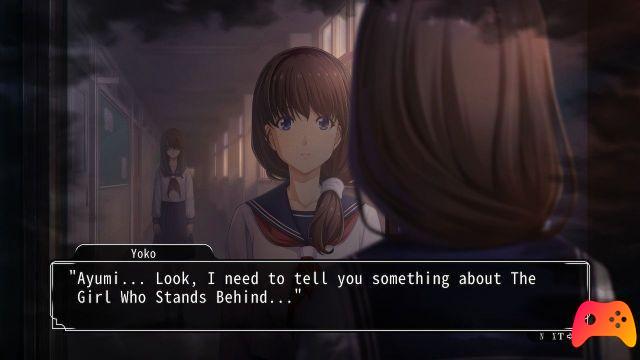
The Girl Who Stands Behind instead tells the first real investigation carried out by the protagonist, how he starts working for the agency after meeting Detective Utsugi and how Ayumi will also join. The prequel has distinctly darker tints than The Missing Heir: following the discovery of a body near the city, the two detectives are contacted at the crime scene for an inspection. It quickly turns out that the body belongs to a girl from Ushimitsu High School, Yoko Kojima. To solve the case, Detective Utsugi suggests that we investigate inside the school. In fact, given the young age of the protagonist (15 years) it will be easier for him to question students and teachers.
As in the first title, here too we have the supernatural element which in this case takes on much more frightening shades. From the very first chapters we learn of a strange story that has been told for many years inside the school, linked to the mysterious disappearance of a student which took place years before. It is said that this girl's ghost has never left school and asks peers for help by appearing with bloodstained clothes. This story that is told to us will accompany us for all the chapters of the game and will give life to very tense scenarios in which the protagonist will be led to wonder if ghosts really exist. Here too, as in the first title, we will go to the agency to formulate hypotheses on the case. The one who will help us most in the investigation, however, will be Detective Utsugi.
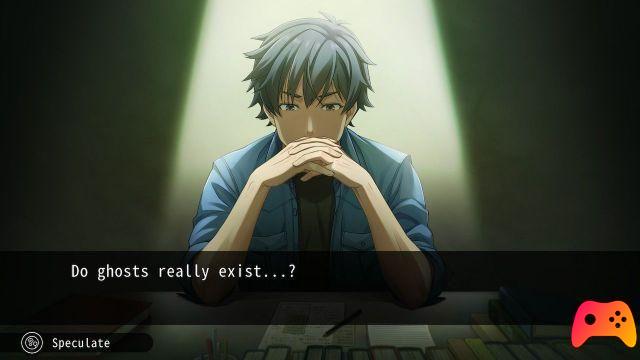
In both cases the game modes are the same. Our aim will be to gather information by talking with the characters of the story to solve the case, alternating the questions with the point and click sections. Some interactions we have are Travel, Talk, Take, Call / Engage, Look / Examine and Quit Investigation (the game's "save game"). In The Missing Heir there is also the Remember option which is used to try to regain the memory. In the second title, however, in addition to the aforementioned interactions Remember is replaced by Think which allows you to think or reflect on what to do. In general, when we have discovered an important clue or information it will be possible for us to change the scenario: the yellow color is the sign that progress has been made.
Travel allows you to move from one place to another, not always freely, while Talk is the main command, the one that sees the detective asking questions and getting answers from the interviewees. There are, of course, points that convinced us to take a break, and it often happened that we had to click through all the available options one after the other until we found the right one. This especially happened with The Missing Heir, in that The Girl Who Stands Behind is smoother and more intuitive, finding in the Think option a valuable help when you find yourself stuck.
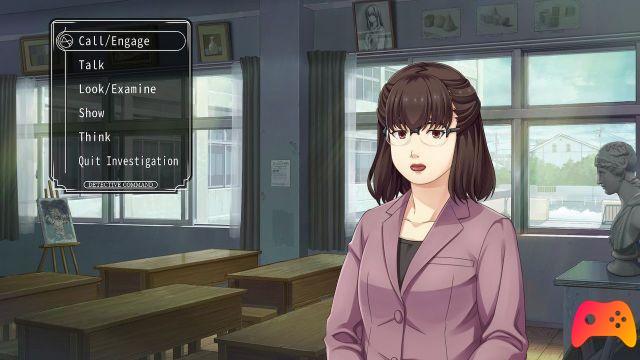
To give a clear example, in the first chapter at a certain point we will be called to go to the cliff at a specific time, and the only way to make this happen will be to talk to the characters (often listening to the same phrases again) until we reach exhaustion. In The Girl Who Stands Behind there is a similar scene, with the difference that in the background there is a clock that is natural to control by triggering the change of scenery, which is more immediate.
As previously written in Famicom Detective Club: The Missing Heir the investigations are carried out for the most part in a rural setting, but you have the possibility to move to more places such as the village station, the Ayashiro residence, the doctor's clinic, the apartment of Amachi, the man who helps us at the foot of the cliff and of course the cliff itself. As the story progresses, therefore, we will meet several characters on whom the suspects will focus and others who will not hesitate to help us: an example is Dr. Kumada, the friendly village doctor with a penchant for beautiful girls, who will improvise detective. to help us in the case.
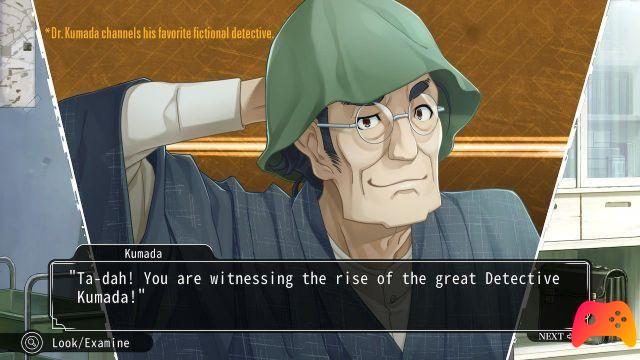
His somewhat bizarre behavior will allow us to smile several times and break the tension that accompanies the case. The comic element is not lacking even in The Girl Who Stands Behind: here too there will be several very funny scenes resulting from the actions of both some characters and the protagonist himself.
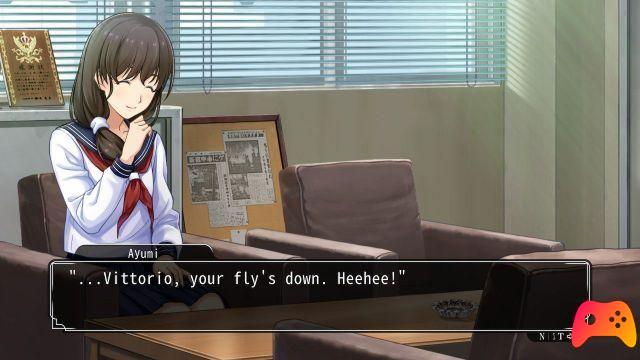
What is important to remember is the information we collect from time to time. There will be no need to take notes, by pressing the + key on the Switch you can consult the Notepad where there are all the characters we meet and the information collected about them. The dialogues can be reread by pressing the X key, to view them again even during an interrogation. Despite this, following the plot is fundamental for a game of this type: not only because in these visual novels the plot is everything, but also because we will also be asked about the case. There are no real puzzles to solve: the focus is mainly on the two cases. It will be easy to make deductions throughout history, but only at the end will we really find out what happened. As lovers of good, engaging stories, we found the two Famicom Detective Clubs enjoyable even in two players, sparking intense conversations about what happened and who could be the culprit. The plots turned out to be compelling as the chapters went by, and without plot holes.
Although the game modes are identical, Famicom Detective Club: The Girl Who Stands Behind differs a lot from The Missing Heir not only for the plot and the different characters but also for the horror element that is much more present here. If in The Missing Heir the scenarios are very bright and also convey a sense of peace in the next title in the school, one of the scenarios where we will carry out most of the investigation, you will always feel the constant presence of the ghost of the missing girl. The mystery will be solved only in the final chapter, where the maximum tension will be reached and the atmosphere will become more and more gloomy.
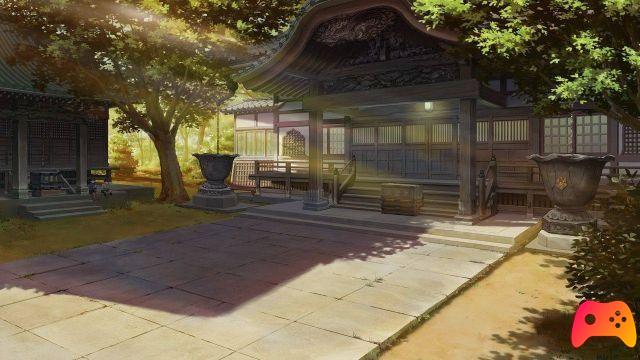
The graphics have been completely redefined. From this point of view, the new Famicom Detective Clubs have been more than restored: Mages has transformed the titles into a very fluid anime, redesigning all the characters and filling all the game's backgrounds with details, even the secondary ones, which unfold on the Nintendo Switch TV or laptop screen between ancient cemeteries and Japanese neighborhoods. The animated scenes are few but impactful - although they are all slightly and more decisively in The Girl Who Stands Behind. Small actions like seeing people drinking coffee add that touch of realism and modernity to the two titles, as it was not possible to imagine long ago.
To make a parallel with another visual novel developed by Mages, who took care of the remakes of the Famicom Detective Club, we wrote that Steins; Gate Elite was penalized by the fact that the anime existed, transposed almost 1: 1 to the video game and that all in all, it was preferable to watch that one. In this case, however, Famicom Detective Clubs are only available as video games and for many people this is possible for the first time. The games arrive localized in English and dubbed completely in Japanese.

The lack of Spanish does not make itself felt much for those who chew a little English, considering that it is always possible to recover the dialogue. For those who are not used to it, unfortunately, we fear that investing in dubbing of other languages would have greatly exceeded the budget for an operation of this type. After all, no one would ever have expected the announcement of a revival of the Famicom Detective Club, but we are happy that Nintendo has made this leap in the dark and has done it in this form, while leaving out the third chapter of the 1997 spin-off. on Satellaview (SNES device that allowed you to download games in installments via satellite).
To corollate the duology there is a Music Mode that allows you to listen to the pieces that accompany the investigations of the protagonist: these are spot on, and range from the solemnity and gravity of the first chapter to being more lively, youthful and sometimes scary in the second, in common agreement with the school and urban context. In the long run, however, they risk being annoying.
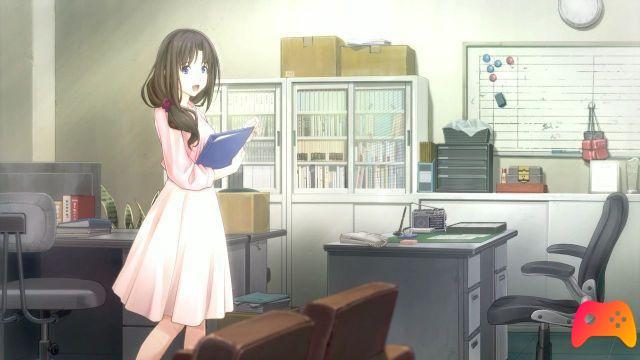
Famicom Detective Club: The Missing Heir and The Girl Who Stands Behind are two valid investigative visual novels, with no particular flaws considering the niche of the genre. Experiencing The Missing Heir and The Girl Who Stands Behind in this modern form is another story altogether. The plots and settings are intriguing and so different as to be tantalizing for everyone, both those who prefer the more classic thrillers and horror-veined thrillers - it is no coincidence that among Sayamoto's inspirations there are films by Dario Argento. Nintendo offers us a bundle with two games with an anime-style graphics, where we are the investigators and the interest grows chapter by chapter. Rediscovering these old titles that have been given a second chance, for the first time outside of Japan where they have been relegated to this day, was in a nutshell unexpectedly exciting.
► Famicom Detective Club: The Missing Heir & The Girl Who Stands Behind is an Adventure type game published by Nintendo for Nintendo Switch, the video game was released on 14/05/2021





